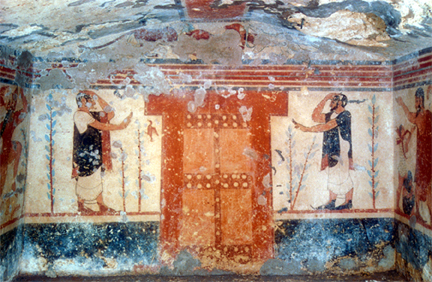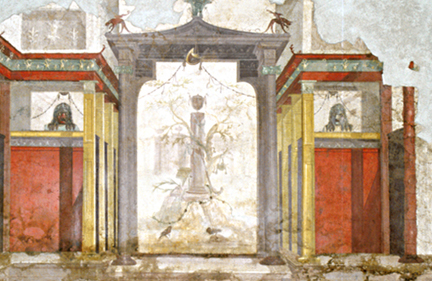The trompe l’oeil door in the Synistor painting is life size and therefore within the context of the room it gave the illusion of being a real door. However, unlike a real door this one is hermetically sealed by the medium of paint. Gilbert Picard, in his book Roman Painting, interprets paintings such as these within the context of Roman religious beliefs and assigns to them a function associated with symbolic entrances and exits that lead to and from the underworld – thus making them highly sophisticated pictorial depictions of either tomb facades, or entrances to Hades, or both (PIcard 1970: 97). The door in the Synistor painting is accompanied by a complex array of images such as the winged figure above the crown of Zeus, the demonic masks and standing candelabra also embellished with numerous winged figures. In addition to these images there is, according to Picard, one primary signifier that above all else transforms the door and the entire wall-painting into a pictorial tomb façade. It is located directly above the door in the form of a frieze depicting the Hunt for the Calydonian Boar (fig.1). Hunting scenes, such as this one, were carved onto the sides of numerous Etruscan and Roman sarcophagi. This leads us to surmise that it was a funerary motif associated with the ‘killing of death’ symbolically portrayed as a wild boar. If we compare this painting with much earlier Etruscan tomb paintings, such as the Tomb of the Augurs, then we can see the door motif being used in a similar context (fig.2). The lamenting Augurs on each side of the door perform a similar cathartic function to that denoted by the hunting frieze. Both doors are, without doubt, emblematic of the impenetrable door that featured in ancient Egyptian, Etruscan and Roman religious beliefs concerning the after-life.
In a few tragic-style paintings, such as the Room of the Masks in the Villa Augustus on the Palatine in Rome, we are allowed a rare opportunity to see through an unrestricted opening into an open space beyond the wall (fig.3). In this hitherto obscured world, we find ourselves confronted by a column on which stands a funerary urn. Beyond it we see the shadowy forms of indistinct shapes, hovering as though in a spatial void, mysteriously lit by a glowing light. The intense light that pervades this scene is not the same light that strikes the architectural facade on either side of the entrance. The respective sources for these illuminations are quite clearly emanating from different sides of the wall. Picard describes the scene beyond the wall as a “rural sanctuary” in which the divinity or heroised ancestor spirit is symbolised by the column and the urn. Traditionally, the bird images also reinforce the notion of a spirit presence. Any impulsive thoughts of entering this sanctified space are soon dispelled by the glowering countenances of the demonic masks, the guardians of the entrance. He also interestingly notes that… “beyond the wall one finds, too, a dissolution of form and a use of almost surrealist colours” (One wonders whom he had in mind?) (Picard 1970: 97).
 1
1 2
2 3
3